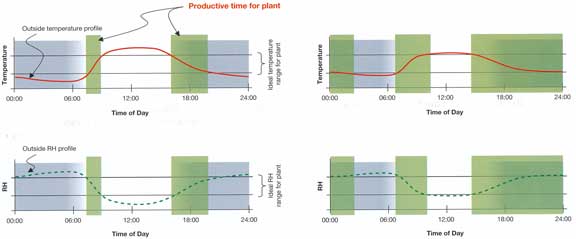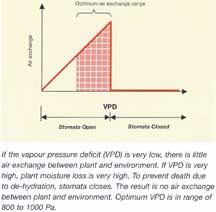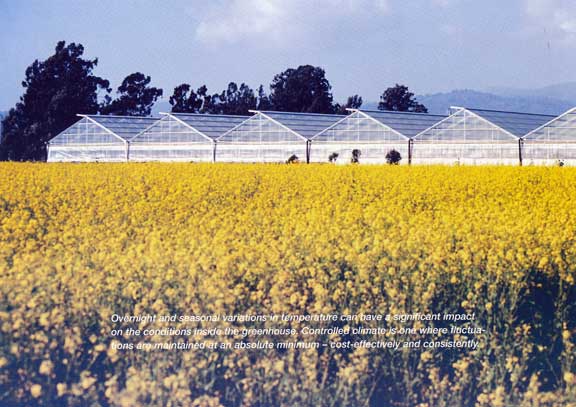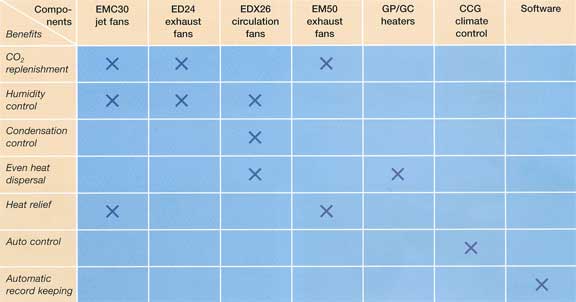An Extra Level of Control for
Naturally Ventilated Greenhouses
Creating perfect conditions for growth
In moderate climates the design of the naturally ventilated greenhouse is popular for the level of protection and control it provides. Problems potentially arise when the natural conditions outside make ventilation impossible or inadequate. An extra level of control helps ensure an ideal growing climate at all times.
While growing in greenhouses reduces the dependence on climatic conditions outside, plant health is still dependent on an equally complex set of micro climate conditions inside. The key to sustained quality, quantity and profitability lies in awareness of these conditions and their impact, and maintaining control of them.
Although the plants are protected from the weather outside, without adequate control equally adverse conditions can still occur inside: extremes of heat and humidity can inhibit growth, limit fruit production and encourage the spread of disease. And as varieties grown inside are frequently more delicate than their tougher cousins traditionally cultivated outside, the results can be devastating.
Temperature, humidity and productivity
Growing inside greenhouses allows plants to grow in temperatures typically between 12-28 °C and relative humidity of around 60-80%. The reason these conditions are ideal is because the plants’ rate of photosynthesis is optimized at this point.



Under these less than ideal conditions, the true potential of that crop will not be reached, yet all of these can be countered; installation of heaters and circulating fans prevents cold spots and stratification of the greenhouse air, reducing the risk of condensation and the onset of wet-induced botrytis; extra exhaust fans generate additional ventilation to prevent extreme temperatures and ensure adequate CO2 concentrations; while high levels of humidity can be prevented with a combination of recirculation fans, extraction fans and heaters.
Carbon dioxide, ventilation and productivity
Just as high concentrations of carbon dioxide have been shown to stimulate plant growth, so reduced levels will effectively slow or stop the process of photosynthesis. This can happen when light levels rise early in the morning without ventilation being triggered. The plants inside will quickly consume the available CO2. Regular controlled ventilation will ensure not only a consistent optimized temperature and a reduced risk of heat stress, it will also replenish the CO2 content. Controlled ventilation will also ensure that all plants within the greenhouse benefit equally from the ventilation, without hot spots, condensation or dead zones. As with humidity control, effective climate control is not just ‘damage limitation’ but a case of plant environment optimization.
 From helping hand to total control
From helping hand to total control
Optimization does not always mean maximization. Achieving the optimal degree of climate control for crops within the greenhouses does not necessarily require a totally closed system with remote and automated control of heating, ventilation,
humidification and dehumidification. It is more important that the tools employed are appropriate to the ambient climate, to the crop requirements and to the budget.
In certain geographical areas, Nature provides very good climatic conditions for plant growth most days — usually within that golden spot of 12-28 °C and less than 80% relative humidity. However, climatic problems do occur. Most nights, the relative humidity exceeds 80%. Some days natural ventilation is not adequate, when the ambient temperature is high or there is no wind. Other days, when the wind is very high, natural
ventilation may not be possible because of the need to close the house. And soon after sunrise, before natural ventilation becomes effective, levels of carbon dioxide are typically low.
In such areas benefits can be derived from installing circulation fans to create an even climate inside the greenhouse. Additional benefits may also be derived from installing some extraction fans for forced ventilation to ensure adequate ventilation every day of the year, no matter what the outside weather situation is.
The benefits
It should be appreciated by now that designing the optimal climate control system requires an understanding of the crop being grown, its preferred temperature and humidity, the growth cycle and the design of the house itself.
Our solutions and products are designed for all commonly-used greenhouse designs. Proper combination of climate control components is a key to optimum growing conditions.

Euroemme fans from Munters combine superb performance with ease of installation and cleaning, while static and dynamic balancing of blades ensures optimal energy efficiency at all times.





 From helping hand to total control
From helping hand to total control